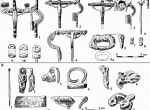Głuszyno
Głuszyno, Słupsk district, Pomeranian Voivodeship (Germ. Gluschow, Kreis Stolp), site of discovery in 1988 in a cemetery of →Wielbark Culture people spanning the early Roman Period phase C1b and early stages of the →Migration Period (onset of phase D), of burials from phase D/E and the onset of phase E of the Migration Period (second half of 5th c.) attributed to a population from the Scandinavian environment. Two graves with stone constructions were discovered: grave 1 (fig. 1.) - an inhumation burial resting supine on the original humus and covered with boulders – a pavement of two layers with a stone circle some distance away. Inventory: (a) three bronze brooches with an elongated head decorated with notching; (b) a bronze brooch with a half-round bow and knobs at the ends of the transverse bar; (c) bronze dress pin with a stylised bird head; (d) iron buckle with a thickened frame; (e) five glass beads, two of them type 18, three - type 30b of Tempelmann-Mączyńska. The grave form (unknown in Pomerania) has affinity with features recorded on the Baltic islands (Gotland, Öland, Bornholm). The same area is suggested also as the source of the grave goods. Brooches with an elongated head are encountered in Scandinavia and in Balt cultures; two such forms, with a slightly elongated head (variant 1a of A. Bitner-Wróblewska), are noted on Öland, Gotland and Bornholm, another, with a markedly elongated head (variant 2, Bornholm according to A. Bitner-Wróblewska) are limited to Bornholm. The brooch with a half-round bow belongs to a typologically mixed group, widespread on the Baltic islands, but mainly known from Gotland. The bronze pin is a dress accessory typical for the Baltic Sea basin, Finland in particular, (e.g., Hiidentöykku). The iron buckle is a form encountered in various parts of the Barbaricum → (e.g., Kuchelmiss, grave 4; Mörbisch, grave BN; Erding – Altenerding, grave 1299). Glass beads appear as dress accessories in Pomerania during the Roman Period and the →Migration Period . Chronology of the grave: second half of 5th century AD (phase E). Grave 2 (fig. 2.) – a cremation burial deposited with a layer of ashes covered with a pavement surrounded by a stone circle. Inventory: (a) comb fragment; (b) pale green glass fragment; (c) bronze anthropomorphic belt mount; (d) bronze pin with a round head; (e) bronze sheet fragment; (f) bronze ring or link; (g) three glass beads, burnt. The grave form (unknown in Pomerania) has affinity in Scandinavian deposits. As for the grave goods, the anthropomorphic mount resembles artefacts from Gotland (e.g., Gröntlingbo), the dress pin with a round head is of a form known from Gotland and Bornholm. Chronology of the grave: second half of 5th c. AD. The graves discovered at G. are relics of a small pocket of Scandinavian settlement in the basin of the Middle Łupawa and the Łeba rivers datable to the second half of the 5th and early 6th century (G., →Główczyce , Gorzano, Witkowo), one of the last elements of Antique tradition in Pomerania. It presumably documents contacts of the population in Pomerania with the Baltic islands, Bornholm and Gotland in particular. The artefacts from G. are at present in the district museum (Muzeum Okręgowe) in Koszalin.
HM
Literature: H. Machajewski, Skandynawskie elementy kulturowe na Pomorzu Zachodnim z okresu wędrówek ludów (2 połowa IV w. – początek VI w.), Przegląd Archeologiczny, vol. 40, 1992, p. 71-96; H. Machajewski, Dwa cmentarzyska z późnego okresu rzymskiego i wczesnej fazy okresu wędrówek ludów oraz z późnej fazy okresu wędrówek ludów na stanowisku 1 w Głuszynie, woj. słupskie, Folia Praehistorica Posnaniensia, vol. VII, 1995, p. 155-235.
-
 full resolution
full resolution
Fig. 1-2. Grave goods from inhumation (no. 1) and cremation (no. 2) graves, Głuszyno, Słupsk district (H. Machajewski 1992, p. 79, Fig. 5).


